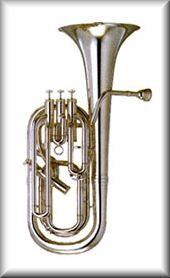
The baritone horn is a member of the saxhorn family like the tenor horn. Baritones are built in a similar pattern to the tenor horn, with an upright pattern. It is pitched in B𝄬, a perfect fifth below the tenor horn and in the same octave as the tenor trombone and euphonium. The bore is moderately conical, and the color of the sound is midway between the bright sound of the cornet and the mellow sound of the euphonium. There are three or four valves, usually of the piston design, with the fourth valve lowering the pitch by 2.5 steps, the same as the combination first + third, which is always sharp. Some newer baritones include a lever (trigger) mechanism to moves a tuning slide so that the pitch can be altered while the instrument is in use.
Role in the Brass Band
The baritone is gneerally assigned the tenor part in a four-part arrangements. Full-band instrumentation generally has two baritone parts. The baritone is often used to supply a bass note to the horn section. and also frequently doubles the euphonium parts. The baritone is not often used as a solo instrument, having been traditionally considered as less agile and interesting than the euphonium. However, the advent of the four-valve baritone has extended its range downward. In recent years, especially in the contesting band arena, baritone solos and solo specialists have become more common.
